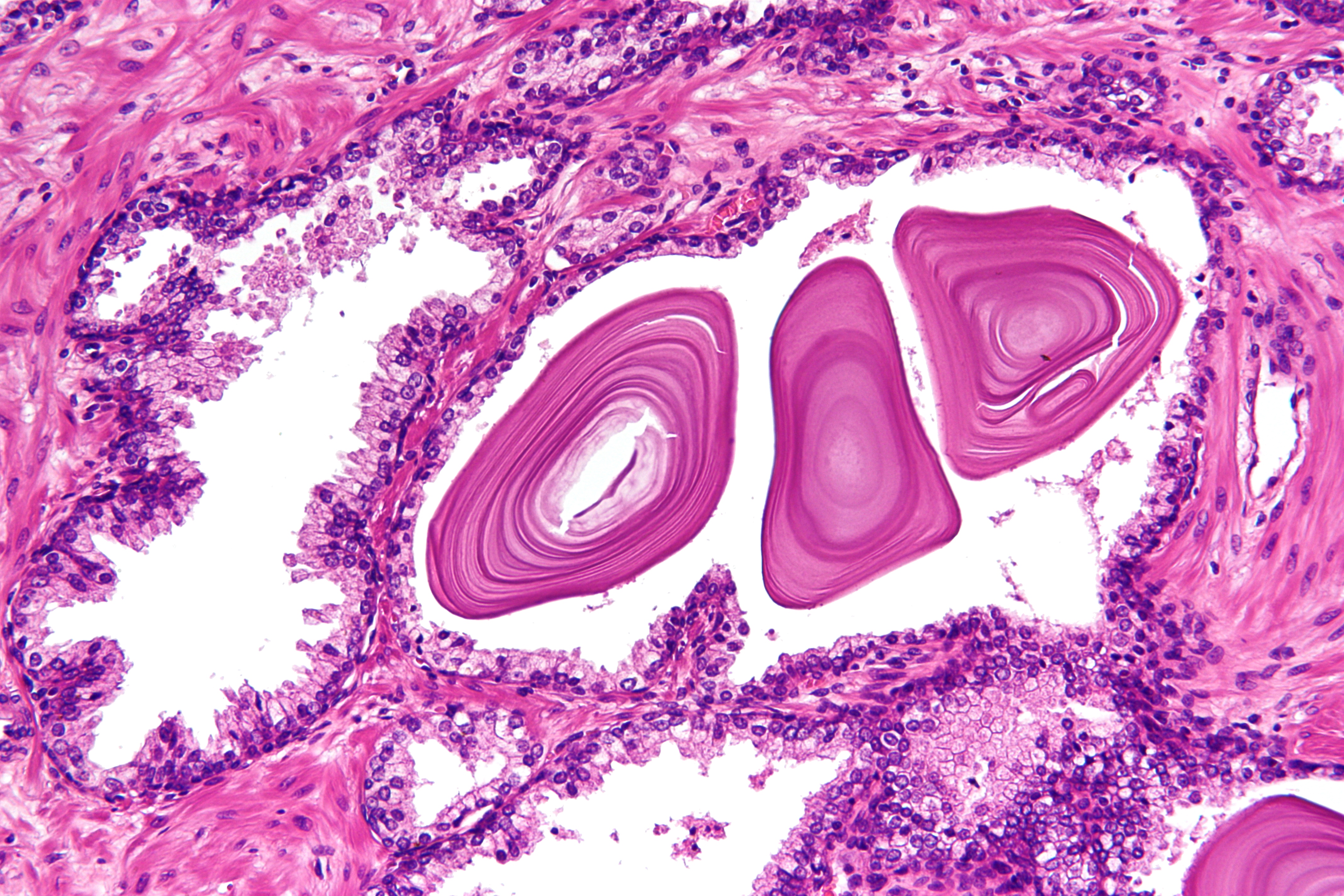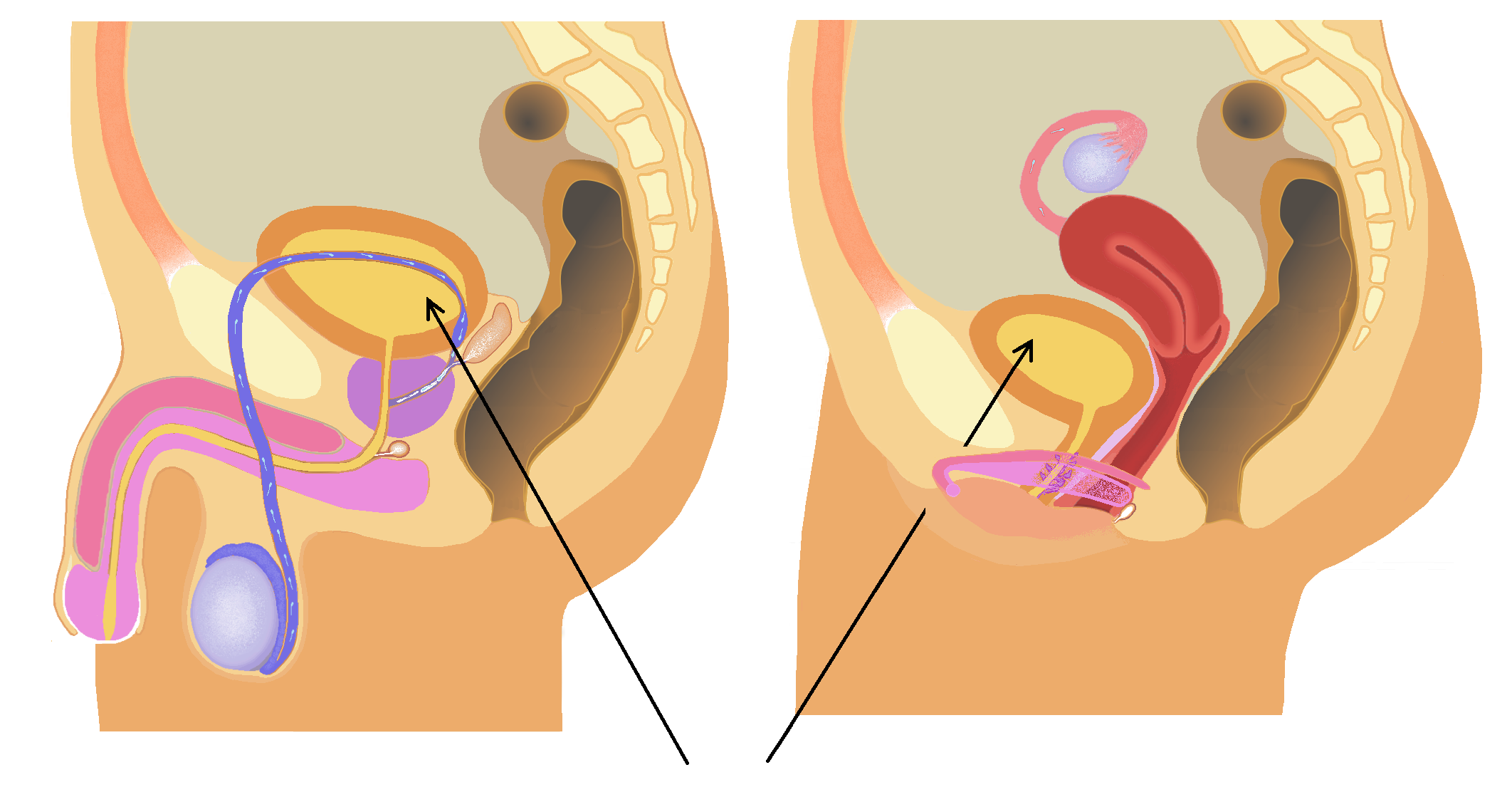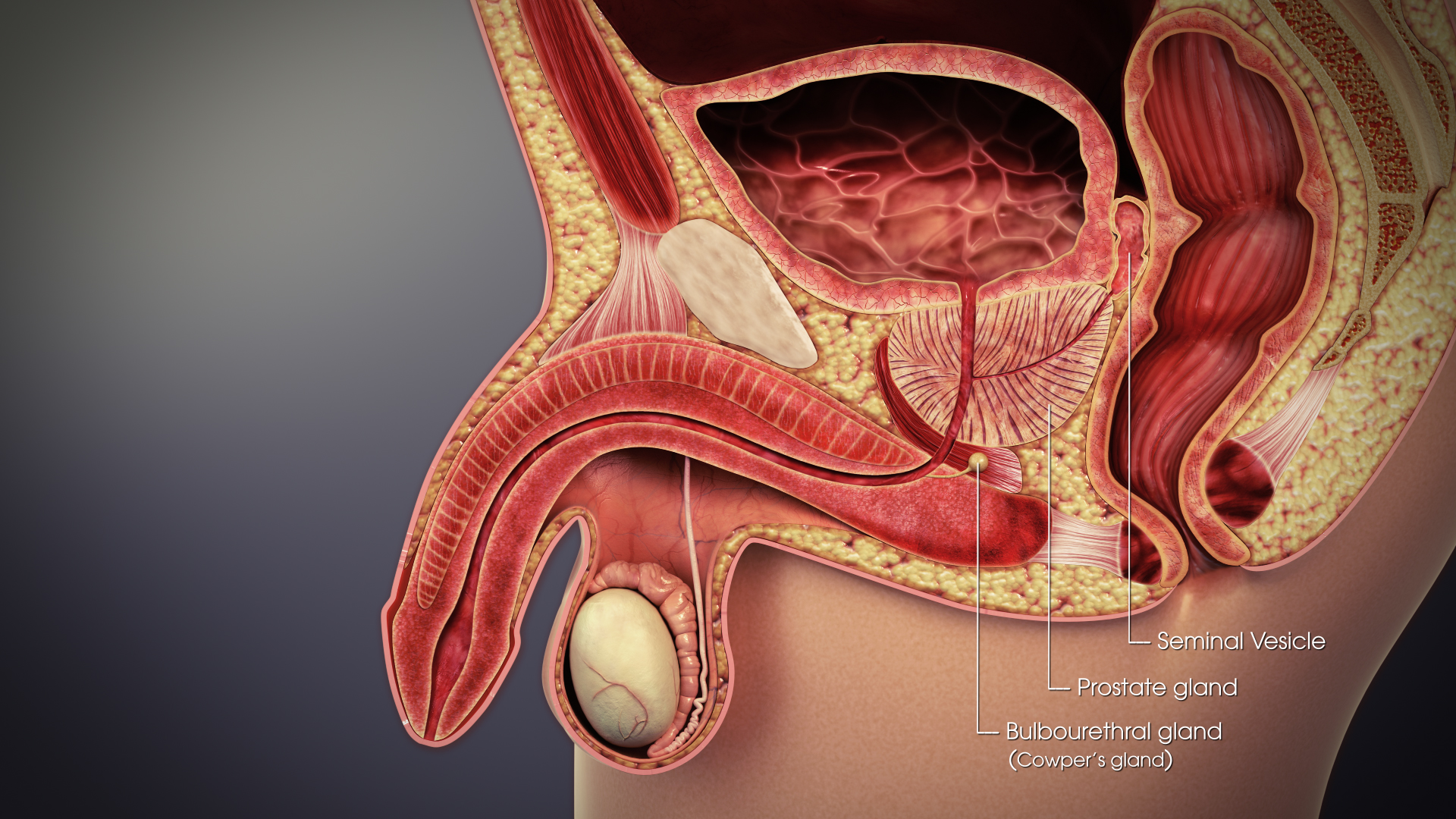|
Prostate
The prostate is an male accessory gland, accessory gland of the male reproductive system and a muscle-driven mechanical switch between urination and ejaculation. It is found in all male mammals. It differs between species anatomically, chemically, and physiologically. Anatomically, the prostate is found below the bladder, with the urethra passing through it. It is described in gross anatomy as consisting of lobes and in microanatomy by zone. It is surrounded by an elastic, fibromuscular capsule and contains glandular tissue, as well as connective tissue. The prostate produces and contains fluid that forms part of semen, the substance emitted during ejaculation as part of the male human sexual response cycle, sexual response. This prostatic fluid is slightly Alkalinity, alkaline, milky or white in appearance. The alkalinity of semen helps neutralize the acidity of the vagina, vaginal tract, prolonging the lifespan of sperm. The prostatic fluid is expelled in the first part of ej ... [...More Info...] [...Related Items...] OR: [Wikipedia] [Google] [Baidu] |
Benign Prostatic Hyperplasia
Benign prostatic hyperplasia (BPH), also called prostate enlargement, is a noncancerous increase in size of the prostate gland. Symptoms may include frequent urination, trouble starting to urinate, weak stream, urinary retention, inability to urinate, or urinary incontinence, loss of bladder control. Complications can include urinary tract infections, bladder stones, and chronic kidney problems. The cause is unclear. Risk factors include a family history, obesity, type 2 diabetes, not enough exercise, and erectile dysfunction. Medications like pseudoephedrine, anticholinergics, and calcium channel blockers may worsen symptoms. The underlying mechanism involves the prostate pressing on the urethra thereby making it difficult to pass urine out of the bladder. Diagnosis is typically based on symptoms and Physical examination, examination after ruling out other possible causes. Treatment options include lifestyle changes, medications, a number of procedures, and surgery. In th ... [...More Info...] [...Related Items...] OR: [Wikipedia] [Google] [Baidu] |
Ejaculation
Ejaculation is the discharge of semen (the ''ejaculate''; normally containing sperm) from the penis through the urethra. It is the final stage and natural objective of male sexual stimulation, and an essential component of natural conception. After forming an erection, many men emit Pre-ejaculate, pre-ejaculatory fluid during stimulation prior to ejaculating. Ejaculation involves involuntary Muscle contraction, contractions of the pelvic floor and is normally linked with orgasm. It is a normal part of male Puberty, human sexual development. Ejaculation can occur spontaneously during sleep (a nocturnal emission or "wet dream") or in rare cases because of prostate, prostatic disease. ''Anejaculation'' is the condition of being unable to ejaculate. ''Painful ejaculation, Dysejaculation'' is an ejaculation that is painful or uncomfortable. Retrograde ejaculation is the backward flow of semen from the urethra into the urinary bladder, bladder. Premature ejaculation happens shortly ... [...More Info...] [...Related Items...] OR: [Wikipedia] [Google] [Baidu] |
Prostatic Venous Plexus
The prostatic veins form a well-marked prostatic plexus which lies partly in the fascial sheath of the prostate and partly between the sheath and the prostatic capsule. It collects blood from the prostate, and (via the v. dorsalis profunda clitoridis) the corpora cavernosa of penis. It communicates with the pudendal and vesical plexuses. It is sometimes known as "''Santorini's plexus''", named for the Italian anatomist Giovanni Domenico Santorini. Clinical significance The prostatic venous plexus drains into the internal iliac vein which in turn connects with the vertebral venous plexus; this is thought to be the route of bone metastasis Bone metastasis, or osseous metastatic disease, is a category of cancer metastases that result from primary tumor invasions into bones. Bone-originating primary tumors such as osteosarcoma, chondrosarcoma, and Ewing sarcoma are rare; the most commo ... of prostate cancer. References External links * - "The Male Pelvis: The Prostate G ... [...More Info...] [...Related Items...] OR: [Wikipedia] [Google] [Baidu] |
Bladder
The bladder () is a hollow organ in humans and other vertebrates that stores urine from the kidneys. In placental mammals, urine enters the bladder via the ureters and exits via the urethra during urination. In humans, the bladder is a distensible organ that sits on the pelvic floor. The typical adult human bladder will hold between 300 and (10 and ) before the urge to empty occurs, but can hold considerably more. The Latin phrase for "urinary bladder" is ''vesica urinaria'', and the term ''vesical'' or prefix ''vesico-'' appear in connection with associated structures such as vesical veins. The modern Latin word for "bladder" – ''cystis'' – appears in associated terms such as cystitis (inflammation of the bladder). Structure In humans, the bladder is a hollow muscular organ situated at the base of the pelvis. In gross anatomy, the bladder can be divided into a broad (base), a body, an apex, and a neck. The apex (also called the vertex) is directed forward toward th ... [...More Info...] [...Related Items...] OR: [Wikipedia] [Google] [Baidu] |
Urethra
The urethra (: urethras or urethrae) is the tube that connects the urinary bladder to the urinary meatus, through which Placentalia, placental mammals Urination, urinate and Ejaculation, ejaculate. The external urethral sphincter is a striated muscle that allows voluntary control over urination. The Internal urethral sphincter, internal sphincter, formed by the involuntary smooth muscles lining the bladder neck and urethra, receives its nerve supply by the Sympathetic nervous system, sympathetic division of the autonomic nervous system. The internal sphincter is present both in males and females. Structure The urethra is a fibrous and muscular tube which connects the urinary bladder to the external urethral meatus. Its length differs between the sexes, because it passes through the penis in males. Male In the human male, the urethra is on average long and opens at the end of the external urethral meatus. The urethra is divided into four parts in men, named after the lo ... [...More Info...] [...Related Items...] OR: [Wikipedia] [Google] [Baidu] |
Semen
Semen, also known as seminal fluid, is a bodily fluid that contains spermatozoon, spermatozoa which is secreted by the male gonads (sexual glands) and other sexual organs of male or hermaphrodite, hermaphroditic animals. In humans and placental mammals, seminal fluid is ejaculation, ejaculated through the penis and contains Proteolytic enzyme, proteolytic and other enzymes as well as fructose, which promote the survival of spermatozoa and provide a medium through which they can move or "swim" from the vagina into the uterus to fertilization, fertilize the female ovum and form a zygote. semen collection, Semen is collected from animals for artificial insemination or cryoconservation of genetic material. Cryoconservation of animal genetic resources is a practice that calls for the collection of semen in efforts for conservation of a particular breed. Physiology Fertilization Depending on the species, spermatozoa can fertilize ova externally or internally. In external fertiliz ... [...More Info...] [...Related Items...] OR: [Wikipedia] [Google] [Baidu] |
Male Reproductive System
The male reproductive system consists of a number of sex organs that play a role in the process of human reproduction. These organs are located on the outside of the body, and within the pelvic cavity, pelvis. The main male sex organs are the human penis, penis and the scrotum, which contains the testicles that produce semen and sperm, which, as part of sexual intercourse, Fertilisation, fertilize an ovum in the female's body; the fertilized ovum (zygote) develops into a fetus, which is later born as an infant. The corresponding system in females is the female reproductive system. External genitalia Penis The penis is an intromittent organ with a long Body of penis, shaft, an enlarged bulbous-shaped tip called the Glans penis, glans and its foreskin for protection. Inside the penis is the Urethra#Male, urethra, which is used to ejaculation, ejaculate semen and to excrete urine. Both substances exit through the Urinary meatus, meatus. When a male becomes Sexual arousal, sex ... [...More Info...] [...Related Items...] OR: [Wikipedia] [Google] [Baidu] |
Male Accessory Gland
Male accessory glands (MAG) are the seminal vesicles, prostate gland, and the bulbourethral glands. These glands are found only in mammals. In insects, male accessory glands produce products that mix with the sperm to protect and preserve them, including seminal fluid proteins. Some insecticides can induce an increase in the protein content of the male accessory glands of certain types of insects. This has the unintended effect of increasing the number of offspring they produce. The accessory glands of male mammals secrete fluid for nourishment of sperm and sexual attraction. Accessory glands The male accessory glands are the ampullary gland, seminal vesicle, prostate, bulbourethral gland, and urethral gland. The products of these glands serve to nourish and activate the spermatozoa, to clear the urethral tract prior to ejaculation, serve as the vehicle of transport of the spermatozoa in the female tract, and to plug the female tract after placement of spermatozoa to ... [...More Info...] [...Related Items...] OR: [Wikipedia] [Google] [Baidu] |
Urination
Urination is the release of urine from the bladder through the urethra in Placentalia, placental mammals, or through the cloaca in other vertebrates. It is the urinary system's form of excretion. It is also known medically as micturition, voiding, uresis, or, rarely, emiction, and known colloquially by various names including peeing, weeing, pissing, and euphemistically number one. The process of urination is under voluntary control in healthy humans and #Animals, other animals, but may occur as a reflex in infants, some elderly individuals, and those with neurological injury. It is normal for adult humans to urinate up to seven times during the day. In some animals, in addition to expelling waste material, urination #Other animals, can mark territory or express submissiveness. Physiologically, urination involves coordination between the central nervous system, central, autonomic nervous system, autonomic, and somatic nervous systems. Brain centres that regulate urination in ... [...More Info...] [...Related Items...] OR: [Wikipedia] [Google] [Baidu] |
Inferior Vesical Artery
The inferior vesical artery (or inferior vesical artery) is an artery of the pelvis which arises from the internal iliac artery and supplies parts of the urinary bladder as well as other structures of the urinary system and structures of the male reproductive system. Some sources consider this vessel to be present only in males, and cite the vaginal artery as the homologous structure in females; others consider it to be present in both sexes, with the vessel taking the form of a small branch of a vaginal artery in females. Structure Origin The inferior vesical artery is a branch of the anterior division of the internal iliac artery. It frequently has a common origin with the middle rectal artery. Course The inferior vesical artery passes medially across the pelvic floor. Distribution The inferior vesical artery is distributed to the trigone and inferior portion of the urinary bladder, the ureter, prostate, vas deferens, and seminal vesicles.vas deferens The vas ... [...More Info...] [...Related Items...] OR: [Wikipedia] [Google] [Baidu] |
Male Reproductive System
The male reproductive system consists of a number of sex organs that play a role in the process of human reproduction. These organs are located on the outside of the body, and within the pelvic cavity, pelvis. The main male sex organs are the human penis, penis and the scrotum, which contains the testicles that produce semen and sperm, which, as part of sexual intercourse, Fertilisation, fertilize an ovum in the female's body; the fertilized ovum (zygote) develops into a fetus, which is later born as an infant. The corresponding system in females is the female reproductive system. External genitalia Penis The penis is an intromittent organ with a long Body of penis, shaft, an enlarged bulbous-shaped tip called the Glans penis, glans and its foreskin for protection. Inside the penis is the Urethra#Male, urethra, which is used to ejaculation, ejaculate semen and to excrete urine. Both substances exit through the Urinary meatus, meatus. When a male becomes Sexual arousal, sex ... [...More Info...] [...Related Items...] OR: [Wikipedia] [Google] [Baidu] |
Connective Tissue
Connective tissue is one of the four primary types of animal tissue, a group of cells that are similar in structure, along with epithelial tissue, muscle tissue, and nervous tissue. It develops mostly from the mesenchyme, derived from the mesoderm, the middle embryonic germ layer. Connective tissue is found in between other tissues everywhere in the body, including the nervous system. The three meninges, membranes that envelop the brain and spinal cord, are composed of connective tissue. Most types of connective tissue consists of three main components: elastic and collagen fibers, ground substance, and cells. Blood and lymph are classed as specialized fluid connective tissues that do not contain fiber. All are immersed in the body water. The cells of connective tissue include fibroblasts, adipocytes, macrophages, mast cells and leukocytes. The term "connective tissue" (in German, ) was introduced in 1830 by Johannes Peter Müller. The tissue was already recognized as ... [...More Info...] [...Related Items...] OR: [Wikipedia] [Google] [Baidu] |









